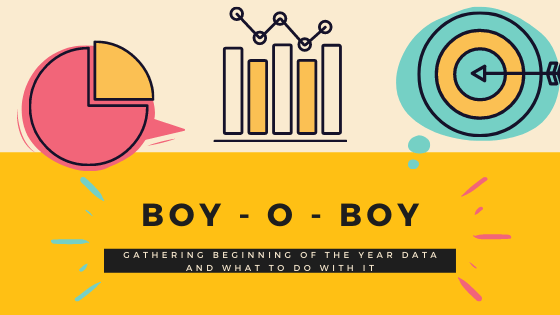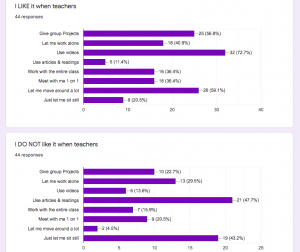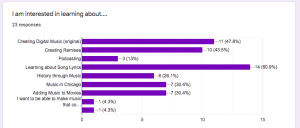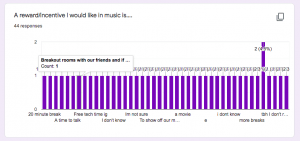
BOY-o-boy: Gathering Beginning of the Year Data
As the school year begins, teachers are setting up their classrooms (or virtual ones), prepping materials, and establishing norms. It’s tempting to do it all in advance, and might not seem like the best time to gather data. However, this is when you can get some of the most important and meaningful information all year. Take this BOY data and use it to drive the direction your students want to go.
 There’s so much on a teacher’s plate at the beginning of the year. You want to get started on the right foot, setting your kids up for success. There are rules and routines, seating charts and supplies, bathroom and brain breaks, and a ton of other new stuff that has come with remote learning. It’s all important, all of it, so don’t skip any of it! This is the time of year you need to establish your community and gain student buy-in. I’ve talked about how important student voice is to fostering these ideas, and writing up a social contract is a wonderful way to accomplish these goals. Content isn’t even on the agenda right now, and so you might be confused when I’m talking about “gathering data.” However, in this new reality, we face as teachers and learners, this might be some of the most important data you get all year.
There’s so much on a teacher’s plate at the beginning of the year. You want to get started on the right foot, setting your kids up for success. There are rules and routines, seating charts and supplies, bathroom and brain breaks, and a ton of other new stuff that has come with remote learning. It’s all important, all of it, so don’t skip any of it! This is the time of year you need to establish your community and gain student buy-in. I’ve talked about how important student voice is to fostering these ideas, and writing up a social contract is a wonderful way to accomplish these goals. Content isn’t even on the agenda right now, and so you might be confused when I’m talking about “gathering data.” However, in this new reality, we face as teachers and learners, this might be some of the most important data you get all year.
Ask your students what they like! Not their favorite animal or pizza topping, but ask them about how they want to learn. It seems so simple, yet rarely do we as teachers do it. I hated group projects as a kid, but I knew plenty of classmates who loved them. As education becomes more personalized, it seems silly to have one-size fit all tasks for students to do. In project-based learning, we talk about form & function, or product and process. You lock one while leaving the other open (my grad school professor likened this to a yin-yang symbol). You either tell the students what they have to do, but leave the content open, or dictate the content but leave the form open. Let’s go back to the introduction question of, “What’s your favorite pizza topping?” You could have each student type it in the Zoom chat, or turn and talk to their neighbors, etc. Or, you could just let them tell you about that topping however they want. Take a platform like SeeSaw, you can ask the question and students have a number of options at their disposal to answer the question. They can write it, draw it, share an image, record their voice, or even a video of them eating the pizza! When students are allowed to approach the topic or assignment in a manner that is amicable to them, you’re going to get a lot more buy-in and subsequently more meaningful results.
So circling back to my main point, ask your students what they like! I usually push out surveys in the first few weeks to find their preferences. Not just how they learn best, but what they want to learn, and what they want as a reward. In-person learning is easy, you can pass out stickers and stamps, give basketball breaks, or pick line leaders. Remote learning doesn’t really allow for the same options, so what do they want instead? You’ll never know if you don’t ask. I’ve been looking at my data as it comes in and I’m seeing a lot of patterns. Students want time to talk, time to work together, and don’t want me to give them things to read (they prefer videos) or reasons to sit still (they want to move). I’ll keep that in mind as I plan moving forward. I’ll also keep in mind what they want to learn as well. I put a few options of units I wanted to teach to my middle schoolers (as well as an ‘other’ option with a fill in the blank) and I was surprised by the results! I never would have that that “learning about song lyrics” would be something that they’re interested in, but it’s literally the number one choice.
So when I talk about gathering data at the beginning of the year, I challenge you to think about what is important. Student voice and choice can have a powerful presence in your classroom, but it’s up to you as the gatekeeper to allow it. Create time and space for your students to speak to their interests, like their likes shine through, and give them a stake in their own learning. I think in this tumultuous 2020, students want to be heard and crave some control over how things turn out. So at the start of this school, maybe one of the best things you can do is just listen.

Nancy Baxendale September 11, 2020 - 7:06 pm
I love this survey! Can you share more details on how the format of the survey, how it was sent to the students, etc?
Thanks
Nancy
Frank Cademartori September 14, 2020 - 4:54 pm
I used Google Forms and pushed it out through Google Classroom. Honestly, Google tools have been so helpful for remote learning. Google Forms automatically took the student responses and converted them to the stat graphs you see in the post. I also shared the results with the class, and I think it really helps to foster that buy-in because they really feel like they have a say in how they learn. In the spring I wrote a post about how I was using these Forms and other tools, you can read (and watch tutorial videos) here – https://asoundmind.edublogs.org/2020/04/20/at-home-learning-using-google-effectively/